Separation of Substances class 6 Science NCERT Solutions
Separation of Substances class 6 Science NCERT Solutions: Separation of Substances is the chapter 4 from class 6 Science NCERT. Here you'll get Separation of Substances class 6 Science/Separation of Substances class 6 Science NCERT Solutions.
Separation of Substances class 6 Science Summary/Main Points
Handpicking, winnowing, sieving, sedimentation, decantation and filtration are some of the methods of separating substances from their mixtures.
Husk and stones could be separated from grains by handpicking. Husk is separated from heavier seeds of grain by winnowing. Difference in the size of particles in a mixture is utilised to separate them by the process of sieving and filtration.
In a mixture of sand and water, the heavier sand particles settle down at the bottom and the water can be separated by decantation. Filtration can be used to separate components of a mixture of an insoluble solid and a liquid.
Evaporation is the process in which a liquid gets converted into its vapour. Evaporation can be used to separate a solid dissolved in a liquid. A saturated solution is one in which no more of that substance can be dissolved.
More of a substance can be dissolved in a solution by heating it. Water dissolves different amount of soluble substances in it.
Separation of Substances class 6 Science Notes
Specially the village children, We all have seen our parents and grandparents separating small stones or pebbles from the rice grains, pulses, filtering tea leaves before serving tea and lot more.
The practice of separation of substances is usually required to remove or separate the required substances from their mixtures. A substance can be classified into Mixture and the pure substance.
Threshing is a process in which we separate grain from stalks. This process is used by farmer to separate gram, wheat, rice, mustard seeds in his field.
 |
| Pic: Threshing |
There are many methods for substance separation from the mixture of the materials which are listed below:
Mixtures: A mixture is a material made up of two or more different substances, which are mixed but are not combined chemically.
Separation: Separation is the process of separating one or more components from a mixture. Example: distillation, sedimentation, filtration etc.
- Sedimentation: This method is used to separate impurities when the heavier component in a mixture settles after water is added to it.
- Decantation: Decantation is the process after sedimentation that involves removing the water, along with the impurities.
- Filtration: Filtration is the process of passing the mixture through a filter to remove the solid particles from the fluid components of the mixture.
Handpicking: Handpicking is a method of separation used to separate large sized impurities like pieces of dirt, stone, and husk from wheat, rice or pulses.
Threshing: Threshing is the process of beating stalks to separate the grains from the harvested crop. It is done manually by farmers, or by threshing machines.
Winnowing: Method of separation used to separate heavier and lighter components of a mixture by wind or by blowing air. This is used to separate husk from grains.
Sieving: Sieving is a method of separation in which the mixture is passed through a filter or a sieve. The difference in the size of particles in a mixture can be separated by sieving.
 |
| Pic: Sieving |
Condensation: The process of conversion of water vapour into its liquid form due to contact with a cooler surface is called condensation.
Evaporation: The process of conversion of water into its vapour is called evaporation.
Sea water contains many salts mixed in it. One of them is common salt, when sea water is allowed to stand in shallow pits, water gets evaporated by sunlight and slowly turns into water vapour. In a few days, the water evaporates completely leaving behind the solid salts. Common salt is then obtained from this mixture of salts by further purification.
NCERT Solutions for Class 6 Science Separation of Substances chapter 4
Exercise
1. Why do we need to separate different components of a mixture ? Give two examples.
Ans: We need to separate different components of a mixture to separate the useful components from the non-useful or some harmful components.
Examples:
(a) Tea leaves are separated from the liquid with a strainer while preparing tea.
(b) Stone pieces from wheat, rice or pulses are picked out by hand.
2. What is winnowing ? Where is it used ?
Ans: Winnowing is used to separate heavier and lighter components of a mixture by wind or by blowing air.
This process is used by farmers to separate lighter husk particles from heavier seeds of grain.
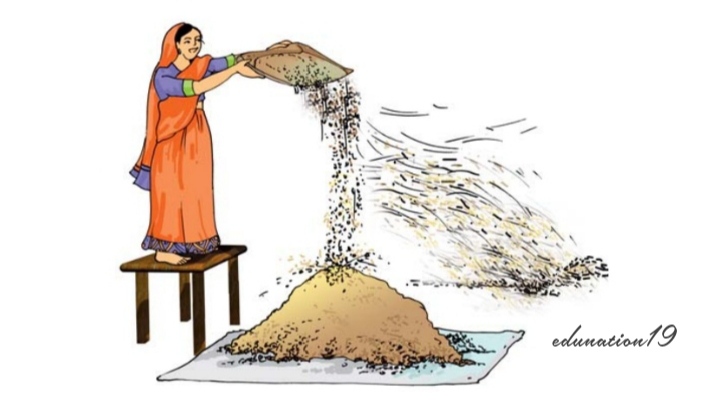 |
| Pic: Winnowing |
3. How will you separate husk or dirt particles from a given sample of pulses before cooking.
Ans: We will separate husk or dirt particles from a given sample of pulses by the handpicking method.
The handpicking method can be used for separating slightly larger sized impurities like the pieces of dirt, stone, and husk from wheat, rice or pulses.
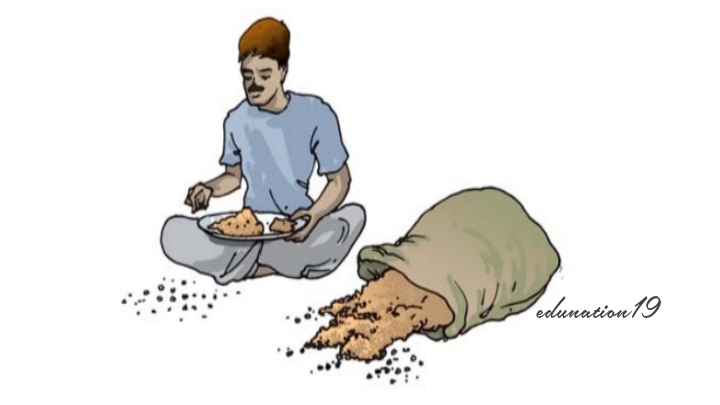 |
| Pic: Handpicking |
NCERT Solutions of Class 6 Science Separation of Substances chapter 4
4. What is sieving ? Where is it used ?
Ans: Sieving is a process that allows the fine flour particles to pass through the holes of the sieve while the bigger impurities remain on the sieve.
It is uses in flour mill, in a flour mill, impurities like husk and stones are removed from wheat before grinding it by sieving.
 |
| Pic: Sieving |
5. How will you separate sand and water from their mixture ?
Ans: We can separate sand and water by sedimentation and decantation method by following these steps;
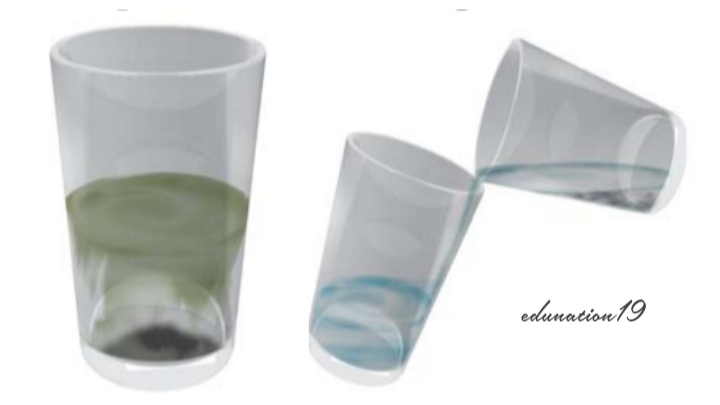 |
| Pic: Separating two components of a mixture by sedimentation and decantation |
First by sedimentation we leave this mixture for some time. After some time, the sand which is heavier is settled down at the bottom.
After that ny decantation we will pour water into another container and the mixture will be separated.
6. Is it possible to separate sugar mixed with wheat flour ? If yes, how will you do it ?
Ans: Sugar can be separated from wheat flour by sieving. Sugar particles being larger in size are retained by the sieve whereas wheat flour will pass through it.
7. How would you obtain clear water from a sample of muddy water ?
Ans: We will obtain clear water from a sample of muddy water by the process of filtration.
A filter paper is one such filter that has very fine pores in it. A filter paper folded in the form of a cone is fixed in a funnel. The mixture is then poured on the filter paper. Solid particles in the mixture do not pass through it and remain on the filter.
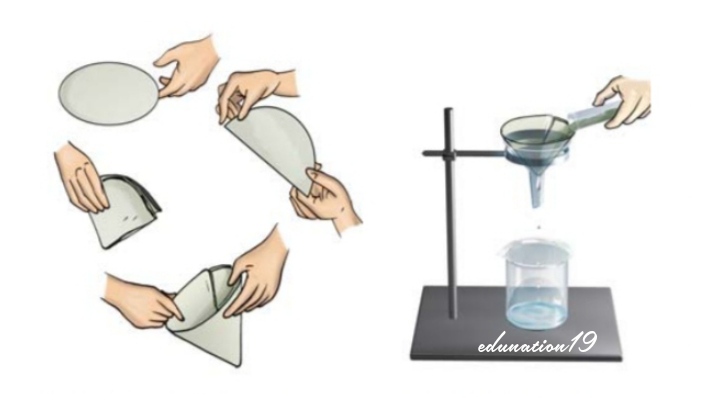 |
| Pic: Folding a filter paper to make a cone & Filtration using a filter paper |
Separation of Substances chapter 4 Questions Answers
8. Fill up the blanks
(a) The method of separating seeds of paddy from its stalks is called ___________.
(b) When milk, cooled after boiling, is poured onto a piece of cloth the cream (malai) is left behind on it. This process of separating cream from milk is an example of ___________.
(c) Salt is obtained from seawater by the process of ___________.
(d) Impurities settled at the bottom when muddy water was kept overnight in a bucket. The clear water was then poured off from the top. The process of separation used in this example is called ___________.
Ans:
(a) The method of separating seeds of paddy from its stalks is called threshing.
(b) When milk, cooled after boiling, is poured onto a piece of cloth the cream (malai) is left behind on it. This process of separating cream from milk is an example of filtration.
(c) Salt is obtained from seawater by the process of evaporation.
(d) Impurities settled at the bottom when muddy water was kept overnight in a bucket. The clear water was then poured off from the top. The process of separation used in this example is called decantation.
9. True or false ?
(a) A mixture of milk and water can be separated by filtration.
(b) A mixture of powdered salt and sugar can be separated by the process of winnowing.
(c) Separation of sugar from tea can be done with filtration.
(d) Grain and husk can be separated with the process of decantation.
Ans: (a) False (b) False (c) False (d) False
10. Lemonade is prepared by mixing lemon juice and sugar in water. You wish to add ice to cool it. Should you add ice to the lemonade before or after dissolving sugar ? In which case would it be possible to dissolve more sugar ?
Ans: We should add ice to the lemonade after dissolving sugar. It is possible to dissolve more sugar before adding ice because When the temperature is high then more sugar can be dissolved. After mixing ice it gets cool and less sugar will dissolve in it.

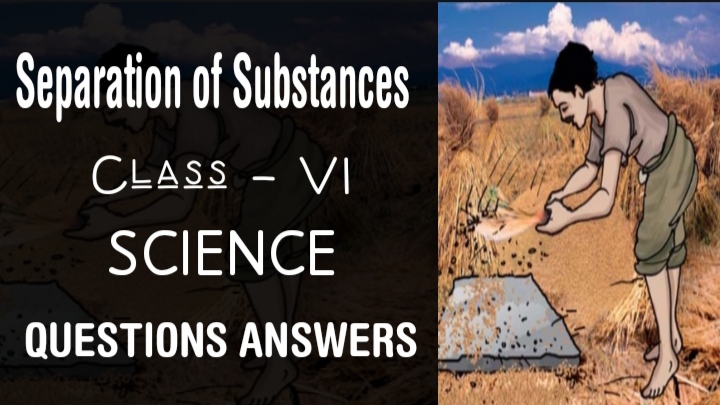






No comments:
Post a Comment
Kindly donnot paste any SPAM link. Thank you very much for reading, Happy learning.